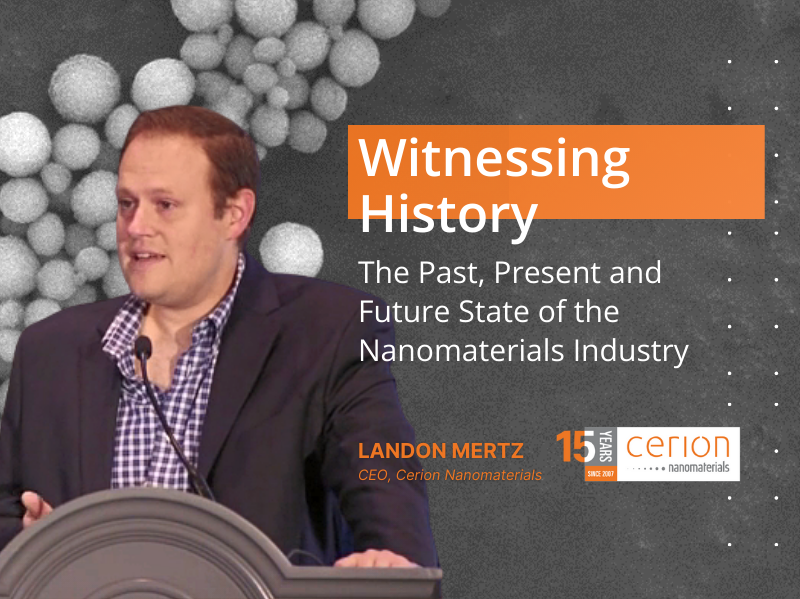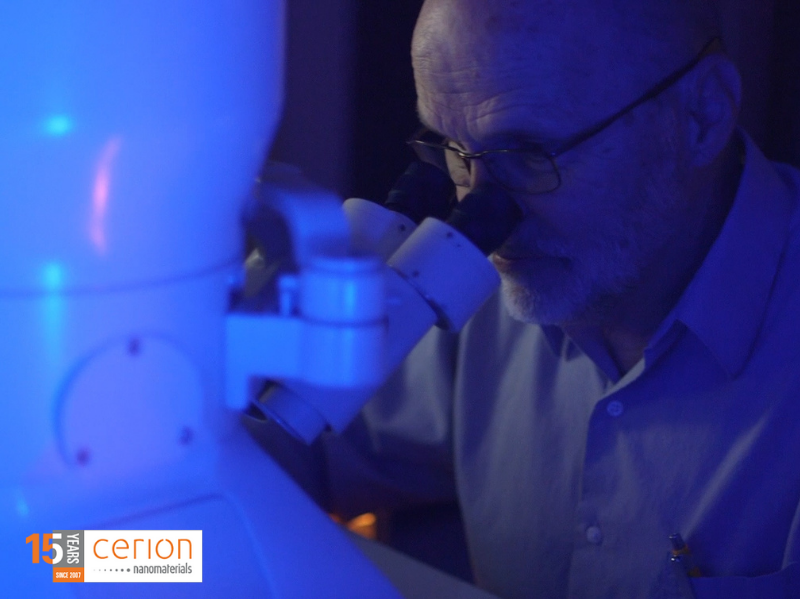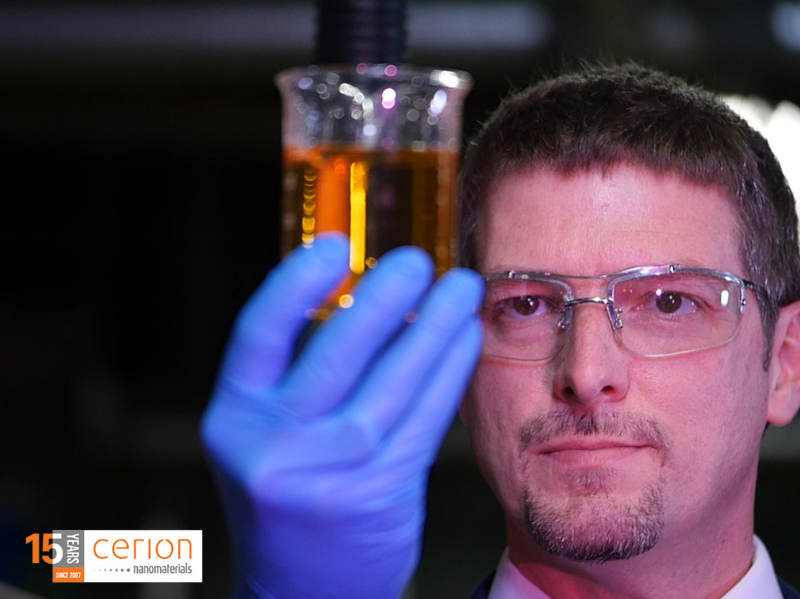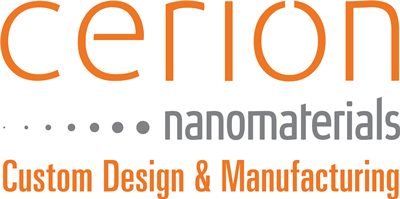The materials industry has changed and evolved over the decades. Can you provide some insight into that history and what has helped grow the industry?
Materials are great technological enablers. Historically, looking much further back than nanomaterials and Cerion, the foundation of virtually every innovation has been preceded and made possible by discoveries in materials.
We can easily identify great civilizations based on their ability to discover and then leverage advanced materials. Damascus steel was a key enabler in early warfare. Modern-day steel was at the heart of the industrial revolution, and, of course, silicon, which brought about computing and communications, revolutionizing nearly every corner of our society.
Often underappreciated, materials have been the foundation on which society has been built. They make our lives safer, more efficient, and more enriching. This will no doubt continue for centuries to come.
Historically the country that had a first-mover advantage in materials also had a first-mover advantage in the technology revolution that followed. This advantage directly correseponded to the country’s economic prosperity, foreign policy influence, and defense posture. First-mover advantage translates to power. Today the United States is in a global competition across several new general-purpose technologies which will shape the future of society – artificial intelligence, quantum computing, biotechnology, and nanomaterials, to name a few.
Nanomaterials touch every industrial sector and are fundamentally altering competition across industries and between nations. Engineered nanomaterials emerged over forty years ago. It is a youthful industry, still coming into its own. Those companies and their product development teams that are leveraging nanomaterials tend to struggle with three key areas: precision design of the nanomaterial to achieve the desired performance benefit, scaling the nanomaterial while preserving its design features, and being able to manufacture that material cost-effectively at industrial scale.
Happily, and because of our business model, Cerion is a notable exception. We recently achieved our 15-year anniversary – no small feat in an industry where we have seen many competitors come and go. Our longevity has been due to our dogmatic approach to solving those three challenge areas and investing heavily behind it, nearly $50 million to date. This has put us far ahead of where most of the nanomaterials industry is at.
We are one of the few nanomaterial companies that do not develop products. We do not make materials to solve one specific industrial challenge (e.g., nano-enabled anti-counterfeiting materials). Rather, we support product development and commercialization teams who are creating products or systems and are looking to leverage the unique properties of nanomaterials. We serve as the subject matter expert on how best to design, scale and manufacture the nanomaterial. Our customer, on the other hand, is the subject matter expert in their product, application, and industry.
We have been able to apply our intellectual and capital resources to focus solely on perfecting the art of making nanomaterials. Our core philosophy is myopically focused on being able to deliver the exact nanomaterial a customer requires cost-effectively at low and high production rates. We have also focused our effort exclusively on inorganic nanomaterials – the bulk of the market – which represent metal, metal oxides, and ceramic nanomaterials.

Image credit: Cerion
We all have heard concerns expressed about the safety of nanomaterials. How does Cerion address that?
Since these materials are ‘relatively new,’ there are times when customers are concerned with the possible health and safety of engineered nanomaterials. This is natural. However, we should first put some important context around the prevalence of engineered nanomaterials.
Nanoparticles are a critical component in the earth’s complex (bio)geochemical system. They have been present since Earth’s origin. Life, from the earliest cells to modern humans, has evolved in intimate association with naturally occurring nanomaterials. As a basic example, if you have walked down the beach, you have encountered nanoparticles from evaporated saltwater and sand. If you have hiked a mountain trail, you have encountered nano-sized minerals from weathered rock. When a volcano erupts, or a forest fire occurs, a portion of the ash comes in the form of nanomaterials. By one popular estimate, there are thousands of teragrams of naturally occurring nanomaterials on our planet (1 teragram = 1 million metric tons = 1 trillion kilograms).
In contrast, during the last 100 years, anthropogenic incidental nanoparticles (produced unintentionally by human activity) have become present. The list of incidental nanoparticles is nearly endless. The summer campfire in your backyard, the soot from the exhaust of your car engine, the breakdown of plastics in your clothing – all of these generate incidental nanomaterials. Today, there are approximately 1 to 10 teragrams of incidental nanomaterials in the environment.
Engineered nanomaterials, on the other hand, are specifically designed and manufactured to serve a purpose. These materials are integrated into many different products across dozens of industries to provide new performance benefits. While no formal study has been conducted, from my direct experience, it would be reasonable to state that the total engineered nanomaterials ever produced represent a mere fraction of a single teragram.
As for the future regulatory environment, I maintain that even if regulators have decided that certain nanomaterials are potentially harmful to human health, they need to look at the actual lifecycle of the material and current production levels. Then, mandate regulatory measures based on the current and projected production, use-related risk levels, and end-of-life fate.
If a nanomaterial is put into a situation where it is being systematically released into the environment, then policymakers must evaluate that use risk and regulate it accordingly. For example, if a nanomaterial is put into fuel to reduce greenhouse gas emissions from an engine. That nanomaterial is going to escape via the exhaust stream, and those potential impacts should be evaluated. At the same time, where there is a closed loop system, there is virtually no risk to the end-user, and regulation needs to reflect this. A great example would be precious or rare earth metals used as a catalyst in a chemical plant. In these scenarios, the regulators should be focused on proper handling, emergency HSE response, and end-of-life remediation plans.
You also must consider that nanomaterials have been widely researched over the last forty years, looking at toxicology and HSE, and there is very little concrete evidence of systemic risk. For example, concerns have been voiced about the infiltration of nanoparticles on the skin. For materials over 10 nm, there is typically no penetration because of the structure of the skin itself. In fact, nanoparticles of zinc oxide are commonly used today in sunscreen. Of course, this is not to downplay possible risks or the need for the scientific study of them but rather to inject a bit of practical common sense into the discussion.
Where do you see the changes or improvements that will drive the next generation of process technologies?
There are two aspects to cover, with the first being the type of synthetic method used to make a nanomaterial and the second being how that method is applied (i.e., batch versus continuous manufacturing).
First, it should be noted that despite marketing claims to the contrary, there is no single synthetic method to make nanomaterials that meet all the varied design, scale, and cost requirements of customers.
We always start with the customer, their needs, and their requirements. We do not focus on one synthetic method and try to shoehorn the customer requirement into that approach. Other companies have become experts in just one type of synthesis so that their answer to every question is that route, which may not always be the best for the customer.
There are a handful of complementary synthetic methods that we have demonstrated to work at scale. We started with precipitation. Precipitation is not one of the more practiced methods of making nanomaterials; however, it offers incredible design flexibility, is very cost-effective, and is one of the most commercially scalable pathways on the market today.
We have expanded our synthesis portfolio to include hydrothermal, solvothermal, and thermal reduction. We have also added the top-down method of high-energy milling, which is a much more powerful and precise tool than ball-milling. Our aim is to produce new classes of materials like nanostructured grains. We are in the more experimental and small pilot stages with customers and their materials now.
On the second point, there are two options - continuous and batch manufacturing - when it comes to nanomaterial production. This is a topic that consistently generates a healthy debate around which is the best alternative for making nanomaterials.
The majority of nanomaterials manufacturing runs on batch processes. When done correctly, it is very cost-efficient. Our customers require high degrees of material customization and have different production volume requirements. This is what batch processes were made for – a platform system capable of producing many different materials under a variety of process conditions. Continuous manufacturing, on the other hand, is best suited to making a single material in high volume. This approach is simply incongruent with the current and future needs of the market.
A close analog to nanomaterials manufacturing would be pharmaceuticals. This industry primarily uses a batch manufacturing platform, where customization and demand are quite similar to our industry. Continuous has been touted for decades as having the potential of delivering cost savings to pharmaceuticals, and yet today, only four out of over 19,000 drugs on the market leverage these processes.

Image credit: Cerion
What does the future of the nanomaterials industry look like to you?
I see continued and accelerated adoption of nanomaterials. We can see this in the pipeline of customers we are supporting today with their product development, who years later will introduce their products to the market. Production scale improvements will continue to drive better economics. As companies like Cerion achieve increased production output, this will drive material costs even lower.
I do see a reordering of the competitive landscape on the horizon over the next two to three decades. The government in China is heavily subsidizing their domestic nanomaterial industrial base. While the technical sophistication of these nanomaterial companies does not yet rise to the levels in the US or EU, they are gaining an unfair competitive advantage globally thanks to their government’s intervention. This will, over time, result in commodity, low-tech nanomaterial supply originating from their markets. This is not dissimilar to previous government interventions in China around solar panels, which resulted in them capturing 85% of global economics. Or in lithium batteries, where they are well down the road in terms of capturing significant market share.
This, in addition to China’s unfair trade practices, means that the focus for nanomaterial users will need to be on rapidly getting to market and achieving first mover advantage within markets. It also means that step-change product improvements are going to be significantly more important than the incremental approach that product developers have focused on for the last 3 to 4 decades.
Industry must play a role, but governments are going to need to consider what their role is as well. Western policymakers must consider what will happen if the US or EU does not dominate or have first mover advantage in a general-purpose technology such as nanomaterials. They will also need to consider what the first, second, and third order impacts will be on our economies, defense posture, and foreign policy.
If future advancements in artificial intelligence or quantum computing are dominated by nations who are near-peer adversaries. Policymakers will not like the risks they see when using this simple thought experiment.

Image credit: Cerion
About Landon Mertz
Landon Mertz is the Chief Executive Officer of Cerion Nanomaterials and is a member of its Board of Directors. Under his leadership for over 10 years, he has overseen a period of expansive business growth and investment into innovations to make advanced expertise in custom nanomaterial design, scale-up & manufacturing accessible and cost-effective for use by industry. Landon has been frequently recognized for his work and is a passionate champion of advancing the growth and maturity of the nanomaterials industry. He is the Chairman and board member of the Nanomaterial Industries Association (NIA), the leading trade association representing users and makers of nanomaterials.

This information has been sourced, reviewed and adapted from materials provided by Cerion Nanomaterials.
This interview is an excerpt of the full discussion – Click here for the full interview contents.
For more information on this source, please visit Cerion Nanomaterials.
Disclaimer: The views expressed here are those of the interviewee and do not necessarily represent the views of AZoM.com Limited (T/A) AZoNetwork, the owner and operator of this website. This disclaimer forms part of the Terms and Conditions of use of this website.